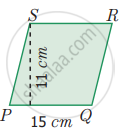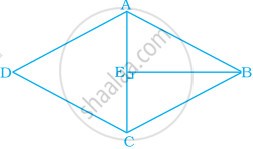Advertisements
Advertisements
Question
The diagonals of a rhombus are 18 cm and 24 cm. Find:
(i) its area ;
(ii) length of its sides.
(iii) its perimeter
Solution
The diagonal of the rhombus is 18 cm and 24 cm.
area of rhombus = `1/2` x Product of diagonals
= `1/2` x 18 x 24
= 216 cm2
(ii)
Diagonals of a rhombus bisect each other at right angles.

∴ OA = `1/2 xx 24 = 12` cm
OB = `1/2 xx 18 = 9` cm
In right ∠d Δ AOB
AB = `sqrt("OA"^2 + "OB"^2)`
= `sqrt((12)^2 + (9)^2)`
= `sqrt(144 + 81)`
= `sqrt(225) = 15` cm
∴ Side of rhombus = 15 cm
(iii)
Perimeter of rhombus = `4 xx "side"`
= `4 xx 15 = 60` cm
(i) 216 cm2 (ii) 15 cm (iii) 60 cm.
APPEARS IN
RELATED QUESTIONS
Lengths of the diagonals of a rhombus are 15 cm and 24 cm, find its area.
If length of a diagonal of a rhombus is 30 cm and its area is 240 sq cm, find its perimeter.
Find the area of rhombus PQRS shown in the following figure.
Find the missing value.
| Diagonal (d1) | Diagonal (d2) | Area |
| 12 mm | 180 sq.mm |
The area of the rhombus with side 4 cm and height 3 cm is
The height of the rhombus whose area 96 sq.m and side 24 m is
The angle between the diagonals of a rhombus is
The figure ABCD is a quadrilateral in which AB = CD and BC = AD. Its area is ______.

What is the area of the rhombus ABCD below if AC = 6 cm and BE = 4 cm?

Area of a rhombus = `1/2` product of ______.
